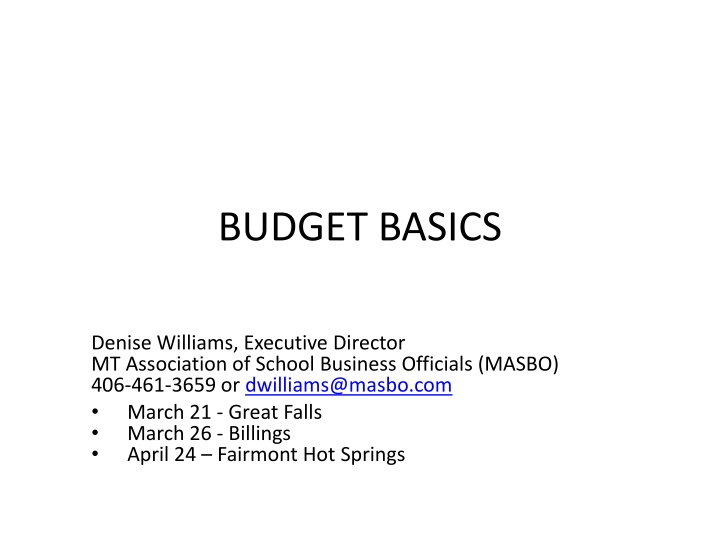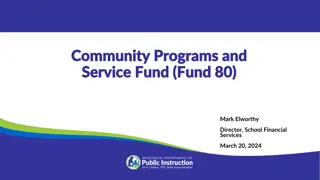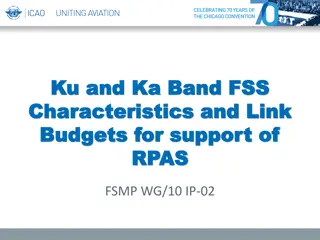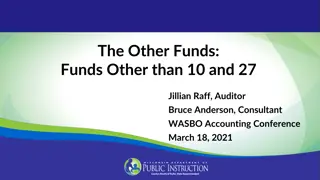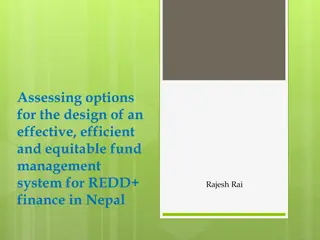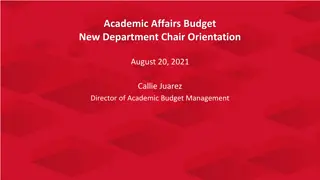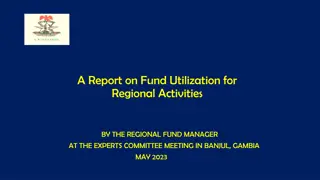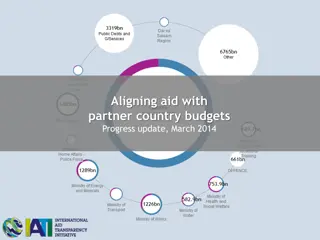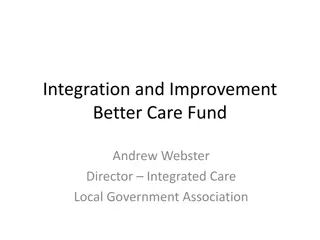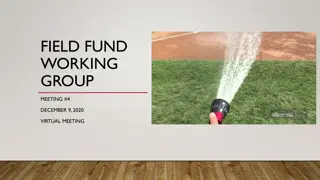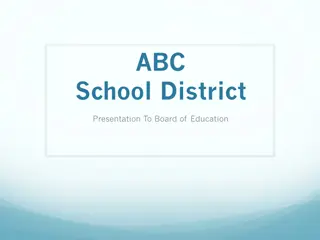Fund Management Essentials for School Budgets
Explore the fundamentals of fund management in school budgeting, including separate funds, budget terminology, and key concepts. Learn the importance of distinct funds, budgeted and non-budgeted funds, and various fund categories for efficient financial management in educational institutions.
Uploaded on Sep 27, 2024 | 1 Views
Download Presentation

Please find below an Image/Link to download the presentation.
The content on the website is provided AS IS for your information and personal use only. It may not be sold, licensed, or shared on other websites without obtaining consent from the author.If you encounter any issues during the download, it is possible that the publisher has removed the file from their server.
You are allowed to download the files provided on this website for personal or commercial use, subject to the condition that they are used lawfully. All files are the property of their respective owners.
The content on the website is provided AS IS for your information and personal use only. It may not be sold, licensed, or shared on other websites without obtaining consent from the author.
E N D
Presentation Transcript
BUDGET BASICS Denise Williams, Executive Director MT Association of School Business Officials (MASBO) 406-461-3659 or dwilliams@masbo.com March 21 - Great Falls March 26 - Billings April 24 Fairmont Hot Springs
BUDGET BASICS Terminology and Key Concepts General Fund Overview Other Budgeted Funds (chart) Non-budgeted funds (chart) Budget Timeline and Q&A
Terminology and Concepts Why do we use separate funds? to account separately for resources affected by different types of spending restrictions because financial reporting standards require it Fund accounting Each fund has a self-balancing set of accounts (debits = credits) to keep the cash flow, revenues, expenditures and equity segregated from the other funds. It is desirable to have as few funds as legal and sound administrative requirements make possible.
Terminology and Concepts 20-9-201, MCA Fund Definitions BUDGETED FUNDS Trustees must adopt a budget to spend money Local property tax levies are a common revenue source NON-BUDGETED FUNDS No budget is needed to spend money Expenditures are limited to cash available in the fund (20-9-210, MCA) No tax revenues Voted Levy hold an election to obtain voter approval Permissive (non-voted) Levy - voter approval not required
FUND # FUND NAME Permissive or Voted Levy? BUDDGETED FUNDS 01 General Permissive and voted 02 Transportation Permissive 11 Bus Depreciation Permissive 13 Tuition Permissive 14 Retirement Permissive (countywide levy) 17 Adult Education Permissive 19 Non-Operating Permissive 28 Technology Voted 29 Flexibility Voted, but tied to state funding 50 Debt Service Voted and permissive (SIDs) 61 Building Reserve Voted and permissive
FUND # FUND NAME 12 Food Service NON-BUDDGETED FUNDS 15 Miscellaneous Programs 18 Traffic Education 20 Lease Rental Agreement 21 Compensated Absences 24 Metal Mines Tax Reserve 25 State Mining Impact 26 Impact Aid 27 Litigation Reserve 45 Permanent Endowment 60 Building 70-72 Enterprise 73-79 Internal Service 82 Interlocal Cooperative 81-85 Other Trust Funds
Terminology and Concepts Budget Authority vs. Cash BUDGET AUTHORITY Budget amounts are estimates of what you intend to receive in revenue and what you intend to spend to operate the school for the year. CASH The actual amount of money you have on hand to spend! Consider this: Not everyone pays their tax bill on time. (revenue doesn t come in when you expect it to) 20-9-133, MCA: Trustees must formally approve (adopt) an expenditure budget in order to spend money during the fiscal year (July 1 June 30). Total expenditures made (or liabilities incurred) during the year must be within the approved budget. Stuff happens! (unanticipated events = unanticipated expenditures
Terminology and Concepts Budget Authority vs. Cash - Example BUDGET AUTHORITY CASH Budgeted Revenues State payments $750,000 Facilities use 15,000 Property Taxes Total $950,000 Actual Revenues Received State payments $750,000 Facilities use 17,000 Property Taxes Total $940,000 185,000 173,000 Actual Expenditures Salaries/Benefits $755,000 Textbooks/supplies 55,000 Facilities maintenance 80,000 Insurance 20,000 Field trips/athletics Total $925,000 Budgeted Expenditures Salaries/Benefits $800,000 Textbooks/supplies 40,000 Facilities maintenance 70,000 Insurance 20,000 Field trips/athletics Total $950,000 15,000 20,000 Change in cash balance $ 15,000
Terminology and Concepts Fund Balance Budget vs. Actual BUDGETED $ 95,000 950,000 950,000 $ 95,000 $ 110,000 ACTUAL $ 95,000 940,000 925,000 Beginning Fund Balance + Revenues - Expenditures Ending Fund Balance
Terminology and Concepts Fund Balance Fund Balance (cash + receivables payables) Beginning Fund Balance (July 1) + Current Year Receipts - Current Year Expenditures Ending Fund Balance (June 30)
Terminology and Concepts Fund Balance - Example Fund Balance (cash + receivables payables) Beginning Fund Balance (July 1) + Current Year Receipts - Current Year Expenditures Ending Fund Balance (June 30) $ 95,000 $940,000 $925,000 $110,000
Terminology and Concepts Fund Balance , Reserves and Reappropriation Fund Balance (cash + receivables payables) Beginning Fund Balance + Current Year Receipts - Current Year Expenditures Ending Fund Balance Reserves (keep for cash flow purposes) Reappropriate (reduces revenue requirement in next year s budget) Return to state (General Fund only)
Terminology and Concepts Fund Balance , Reserves and Reappropriation Reserves - year-end cash balances kept for cash flow Fund Operating Reserve Limit Greater of $10,000 or 10% of ensuing year budget (20-9-104, MCA) General (01) Transportation (10) 20% of ensuing year budget (20-10-144, MCA) Retirement (14) 20% of ensuing year budget (20-9-501, MCA) Adult Ed (17) 35% of ensuing year budget (20-7-713, MCA) Approximate amount of payments due between July 1 and November 30 of second ensuing year (20-9-438, MCA) Debt Service (50)
Terminology and Concepts Fund Balance , Reserves and Reappropriation - Example Fund Balance (cash + receivables payables) Beginning Fund Balance + Current Year Receipts - Current Year Expenditures Ending Fund Balance $ 95,000 940,000 925,000 $ 110,000 Assume next year s adopted budget is $ 975,000 Reserves @ 10% = $97,500
Terminology and Concepts Fund Balance , Reserves and Reappropriation - Example Fund Balance (cash + receivables payables) Beginning Fund Balance + Current Year Receipts - Current Year Expenditures Ending Fund Balance $ 95,000 940,000 925,000 $ 110,000 $97,500 Reserves (keep for cash flow purposes) Reappropriate (reduces revenue requirement in next year s budget) Return to state (General Fund only)
Terminology and Concepts Fund Balance , Reserves and Reappropriation Fund Balance Reappropriated Ending Fund Balance - Reserves = Fund Balance Reappropriated Used in place of new revenue to fund the ensuing year s expenditure budget Reappropriation is mandatory after reserves are maximized General Fund reappropriation is limited to 15% of the maximum budget (excess is remitted to the state)
Terminology and Concepts Fund Balance , Reserves and Reappropriation - Example Fund Balance Reappropriated Ending Fund Balance $ 110,000 - Reserves 97,500 = Fund Balance Reappropriated $ 12,500
Terminology and Concepts Fund Balance , Reserves and Reappropriation - Example Fund Balance (cash + receivables payables) Beginning Fund Balance + Current Year Receipts - Current Year Expenditures Ending Fund Balance $ 95,000 940,000 925,000 $ 110,000 $97,500 Reserves (keep for cash flow purposes) $12,500 Reappropriate (reduces revenue requirement in next year s budget) Return to state (General Fund only)
GENERAL FUND OVERVIEW General Fund Expenditure Budget Limits Funding Sources
General Fund - Budget Elements Basic Entitlement Per-ANB Entitlement Special Education Allowable Cost Payment Quality Educator Payment At-Risk Student Payment Indian Education for All Payment American Indian Achievement Gap Pmt Data for Achievement Payment
Basic Entitlement Rates FY2018 * (HB191) FY2019 * (HB191) Entitlements FY2017 Elementary Basic $ 50,895 $ 51,149 $ 52,105 For every 25 Elem ANB over 250 $ 2,545 $ 2,558 $ 2,606 Middle School Basic $ 101,790 $ 102,299 $ 104,212 For every 45 MS ANB over 450 $ 5,090 $ 5,115 $ 5,211 High School Basic $ 305,370 $ 306,897 $ 312,636 For every 80 HS ANB over 800 $ 15,269 $ 15,345 $ 15,632 *HB191 increased FY2017 by inflation of .5% for FY2018 and 1.85% in FY2019.
General Fund - ANB AVERAGE NUMBER BELONGING (ANB) FALL Example: Oct count = 150 Feb count = 166 ENROLLMENT (1ST Monday in October) Part-time Students = , , or Total of 2 counts divided by 2 (150 + 166) 2 = 158 180 + PIR Days* 180 = ANB X 187 180 SPRING ENROLLMENT (1st Monday in February) Part-time Students = , , or X = 165 ANB *PIR Days are pupil instruction related days for teacher in-service training and recordkeeping
General Fund - ANB Use the ANBthat generates the greatest maximum general fund budget: Current Year ANB (CY ANB) ANB for the budget unit for the ensuing school year (FY2019 ANB is based on FY2018 enrollment counts) 3-Year Average ANB Add current year ANB to the current ANB for the previous two school fiscal years and divide by 3 (FY2019 ANB is the average of FY2018, FY2017 and FY2016) (see section 1. Certified ANB on budget data sheet)
Per-ANB Entitlement Rates FY2018 * (HB191) $5,471 $ 7,005 FY2019* (HB191) $ 5,573 $ 7,136 Entitlements FY2017 Elementary per-ANB High School per-ANB $ 5,444 $ 6,970 *HB191 increased per-ANB entitlements by .5% in FY2018 and 1.85% in FY2019 Each student after the first ANB is decreased by a reduction factor (decrement) per ANB: Elementary ANB decrement is $.20 per ANB High school & 7th - 8th accred ANB decrement is $.50 per ANB
Per-ANB Entitlement Calculations Elementary: $.20 decrement for first 1,000 ANB [$5,573 X Elem ANB] - [.20 X (Elem ANB/2) X (Elem ANB 1)] For each ANB over 1000: ($5,373.20 X ANB) + $5,473,100 7th & 8th accredited: $.50 decrement for first 800 ANB [$7,136 X 7th & 8th ANB] - [.50 X (7&8 ANB/2) X (7&8 ANB 1)] For each ANB over 800: ($6,736.50 X 7&8 ANB) + $5,549,000 High School: $.50 decrement for first 800 ANB [$7,136 HS ANB] - [.50 X (HS ANB/2) X (HS ANB 1)] For each ANB over 800: ($6,736.50 X ANB) + $5,549,000
Special Education Allowable Costs FY2017 $ 42.892 million FY2018* $ 43.292 million FY2019* $ 43.292 million HB 2 Appropriation * Net of reductions under SB261 Special Education Allocation 20-9-321(4)(a), MCA: 52.5% through instructional block grants (ISB) 17.5% through related services block grants (RSBG) 25% to reimbursement of local districts (disproportionate costs) 5% to special education cooperatives and joint boards for admin and travel
Funding Components Quality Educator (QEC) OPI pays to school districts and special education cooperatives Paid for each full-time equivalent (FTE) licensed educator and for other licensed professionals employed by the district or cooperative At-Risk Student (ARC) Annual appropriation is distributed school districts based on Title I allocations
Funding Components (continued) Indian Education for All (IEA) Paid per ANB ($100 minimum) For providing curriculum for the recognition of American Indian cultural heritage American Indian Student Achievement Gap (SAG) Paid per each American Indian student enrolled as reported on the October enrollment count For closing the educational achievement gap that exists between American Indian students and non-Indian students Data for Achievement (D4A) Paid per ANB For access fees or other costs for statewide data system, including data entry and staff training
Funding Components FY2017 FY2018* (HB191) FY2019* (HB191) Quality Educator $3,169 $3,185 $3,245 At-Risk Student (1) Indian Education for All (per ANB) $5,363,730 $5,390,549 $21.25 ($100 min.) $5,463,895 $21.76 ($100 min.) $21.36 ($100 min.) Am Indian Student Achievement Gap Data for Achievement (2) (per ANB) $209 $210 $214 $20.36 $20.46 $20.84 *HB191 increased these payments .5% in FY2018 and 1.85% in FY2019. (1) reduced by SB261 level 2 trigger; (2) suspended by SB261 level 4 trigger
General Fund Budget Limits BASE Budget Maximum Budget* Basic Entitlement 80% 100% Per-ANB Entitlement 80% 100% Special Ed Allowable Cost Payment 140% 175 200% Quality Educator Payment 100% 100% At-Risk Student Payment 100% 100% Indian Education for All Payment 100% 100% Amer. Indian Achievement Gap Pymnt 100% 100% Data For Achievement Payment 100% 100%
General Fund Budget Limits Minimum Budget Requirement ~80% Trustees must adopt a budget that is at least equal to the BASE Budget. BASE Budget Item 9b on your budget data sheet from OPI
General Fund Budget Limits Maximum Budget 100% Over-BASE Budget (funded w/ local property taxes) Item 9c on budget data sheet from OPI BASE Budget
General Fund Budget Limits Over-BASE Budget (funded w/ local property taxes) A district may adopt an expenditure budget that exceeds the BASE budget. The Over-BASE budget is funded primarily through local property taxes at a level approved (authorized) by the voters through a levy election. BASE Budget
General Fund Budget Limits Highest Budget Allowed Over-BASE Budget (funded w/ local property taxes) Highest Budget Allowed Districts may adopt a budget that is the higher of: Current Year Maximum (9c), -OR- Prior Year adopted budget (10d) plus any increases in the Basic and per-ANB entitlements and any increases in the Quality Educator, At-Risk, Indian Education for All, Student Achievement Gap and Data for Achievement payments Item 9e on budget data sheet from OPI Highest Budget with a Vote BASE Budget
General Fund Budget Limits Highest Budget Allowed (9e) Highest Budget allowed without having to ask voters to approve an additional local levy (9d) Voted levy (9f) Permissive Over-BASE Budget (10e) Without seeking additional voter approval, trustees may adopt a General Fund budget that equals their current year BASE budget (9b) plus highest over-BASE levy approved by voters or levied in past five years (10e). BASE Budget (9b on data sheet) Item 9d on budget data sheet from OPI Highest Budget without a Vote
To the Spreadsheet! FY2019 General Fund Budget Worksheet or from the OPI Home Page (www.opi.mt.gov) Leadership Finance & Grants - School Finance Budgets Budget Spreadsheets and Guidance SAVE THIS FILE TO YOUR DESKTOP!
FY2019 General Fund Budget Worksheet Expenditure Budget Limits 1. Enable Editing 2. Enable Content Elem High School K-12 On the Inputs tab: 3. Enter LE C3 C4 C5 4. Enter 2019 Taxable value Q16 S16 U16 5. Compare to Item 9d on data sheet Q31 S31 U31 6. Compare to Item 9e on data sheet 7. Enter Proposed Adopted Budget Q32 Q33 S32 S33 U32 U33
GENERAL FUND REVENUES Funding the BASE budget Funding the over-BASE budget
Funding the BASE Budget Adopted Budget Over-BASE Levy BASE Budget BASE Levy DSA/SPED/ 5 Funding Components Local Revenues Revenues from State
Funding the BASE Budget State funding Direct State Aid 44.7% of the Basic Entitlement 44.7% of the per-ANB Entitlement Special Education Allowable Costs (140%) Funding Components (100%) Quality Educator At-Risk Student Indian Education for All American Indian Achievement Gap Data for Achievement Payment schedule: 10% in Aug Oct and Dec Apr; 20% in June
Funding the BASE Budget Adopted Budget Over-BASE Levy BASE Budget Guaranteed Tax Base Aid (GTB) BASE Levy Direct State Aid (DSA) (44.7% Basic & per-ANB) 100% QEC 100% ARC 100% IEA 100% SAG 100% D4A 140% SPED DSA/SPED/ 5 Funding Components
Funding the BASE Budget Adopted Budget Over-BASE Levy BASE Budget SB 261 cuts for FY18 and FY19: At-Risk payment reduced Data for Achievement payment suspended Guaranteed Tax Base Aid (GTB) BASE Levy Direct State Aid (DSA) (44.7% Basic & per-ANB) 100% QEC 100% ARC 100% IEA 100% SAG 100% D4A 140% SPED DSA/SPED/ 5 Funding Components
Funding the BASE Budget Adopted Budget Over-BASE Levy BASE Budget 35.3% Basic Entitlement + 35.3% Per-ANB Entitlement + 40% SPED Payment BASE Levy Funded with local permissive (non-voted) levy, other non- levy revenue and state GTB aid, if a district is eligible DSA/SPED/ 5 Funding Components
Funding the BASE Budget Adopted Budget Over-BASE Levy BASE Budget FB Reappropriated Oil and gas revenue School Block Grant* Local revenue required to be anticipated Other non-levy revenue K-12 Funding Payment* BASE Levy Revenue that reduces BASE levy requirement DSA/SPED/ 5 Funding Components *Eliminated in HB647 (2017 session)
Funding the BASE Budget State Guaranteed Tax Base Aid (GTB) State subsidy for BASE mills Eligibility is based on the ratio between the district s taxable value and the district s GTB Budget Area as compared to the statewide taxable value X 193%* and the GTB Budget Areas of all districts statewide. Districts with a ratio lower than the statewide ratio qualify for GTB aid. OPI pays General Fund GTB to districts in November and May
Funding the BASE Budget Adopted Budget Over-BASE Levy BASE Budget Guaranteed Tax Base Aid (GTB) If a district is eligible, GTB subsidizes the BASE levy requirement BASE Levy DSA/SPED/ 5 Funding Components
Funding the BASE Budget Adopted Budget Over-BASE Levy BASE Budget FB Reappropriated Oil and gas revenue School Block Grant Local revenue required to be anticipated Other non-levy revenue K-12 Funding Payment BASE Levy GTB Revenue that reduces BASE levy requirement DSA/SPED/ 5 Funding Components *Eliminated in HB647 (2017 session)
Increases in GTB to offset the loss of block grant and NRD payments (HB647) State Guaranteed Tax Base Aid (GTB) State subsidy for BASE mills Eligibility is based on the ratio between the district s taxable value and the district s GTB Budget Area as compared to the statewide taxable value X 193%* and the GTB Budget Areas of all districts statewide. Districts with a ratio lower than the statewide ratio qualify for GTB aid *GTB statewide guarantee ratio FY2018 193% (no change) FY2019 216% FY2020 224% FY2021 232% Districts that already qualify for GTB will receive more More districts will qualify
Funding the BASE Budget FY2018 Adopted Budget Over-BASE Levy BASE Budget BASE Levy (permissive) FB Reappropriated Oil and gas revenue School Block Grant Local revenue required to be anticipated Other non-levy revenue K-12 Funding Payment GTB Increases GTB budget area DSA/SPED/ 5 Funding Components *Eliminated in HB647 (2017 session)
Funding the over-BASE Budget Adopted Budget Funded with voter approved levies and non-levy revenue Over-BASE Levy BASE Budget Guaranteed Tax Base Aid (GTB) BASE Levy DSA/SPED/ 5 Funding Components Local Revenues Revenues from State
